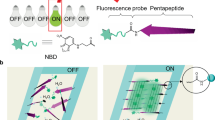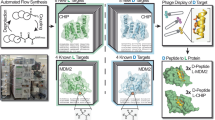Abstract
Dendrimers are branched synthetic macromolecules. This protocol describes the synthesis (1–2 weeks), functional screening (1.5 d) and decoding (2 d) of 'one-bead-one-compound' combinatorial libraries of dendrimers assembled from amino-acid building blocks by 'split-and-mix' solid phase peptide synthesis. The method resembles that for synthesizing linear peptides, except that a branching diamino acid is used at every third position to obtain the dendritic structure. Structural diversification by splitting is restricted to four amino acids per variable position, yielding libraries of ∼60,000 sequences. In such libraries, the sequence of a dendrimer can be deduced uniquely from an amino-acid analysis of the solid support bead. This analysis is more reliable, faster and far less costly than Edman sequencing such that decoding multiple beads is affordable. The method is exemplified for the identification of catalytic peptide dendrimers catalyzing the hydrolysis of acyloxypyrene-trisulfonates with substrate binding (KM = 10–300 μM) and rate accelerations up to kcat/kuncat = 104 in aqueous buffer.
This is a preview of subscription content, access via your institution
Access options
Subscribe to this journal
Receive 12 print issues and online access
$259.00 per year
only $21.58 per issue
Buy this article
- Purchase on Springer Link
- Instant access to full article PDF
Prices may be subject to local taxes which are calculated during checkout





Similar content being viewed by others
References
Lee, C.C., MacKay, J.A., Frechet, J.M.J. & Szoka, F.C. Designing dendrimers for biological applications. Nat. Biotechnol. 23, 1517–1526 (2005).
Swali, V., Wells, N.J., Langley, G.J. & Bradley, M. Solid-phase dendrimer synthesis and the generation of super-high-loading resin beads for combinatorial chemistry. J. Org. Chem. 62, 4902–4903 (1997).
Amblard, M., Fehrentz, J.A., Martinez, J. & Subra, G. Fundamentals of modern peptide synthesis. Methods Mol. Biol. 298, 3–24 (2005).
Esposito, A., Delort, E., Lagnoux, D., Djojo, F. & Reymond, J.L. Catalytic peptide dendrimers. Angew Chem. Int. Ed. Engl. 42, 1381–1383 (2003).
Lagnoux, D., Delort, E., Douat-Casassus, C., Esposito, A. & Reymond, J.L. Synthesis and esterolytic activity of catalytic peptide dendrimers. Chemistry 10, 1215–1226 (2004).
Douat-Casassus, C., Darbre, T. & Reymond, J.L. Selective catalysis with peptide dendrimers. J. Am. Chem. Soc. 126, 7817–7826 (2004).
Furka, A., Sebestyen, F., Asgedom, M. & Dibo, G. General-method for rapid synthesis of multicomponent peptide mixtures. Int. J. Peptide Protein Res. 37, 487–493 (1991).
Lam, K.S. et al. A new type of synthetic peptide library for identifying ligand-binding activity. Nature 354, 82–84 (1991).
Houghten, R.A. et al. Generation and use of synthetic peptide combinatorial libraries for basic research and drug discovery. Nature 354, 84–86 (1991).
Clouet, A., Darbre, T. & Reymond, J.L. A combinatorial approach to catalytic peptide dendrimers. Angew Chem. Int. Ed. Engl. 43, 4612–4615 (2004).
Clouet, A., Darbre, T. & Reymond, J.L. Combinatorial synthesis, selection, and properties of esterase peptide dendrimers. Biopolymers 84, 114–123 (2006).
Kofoed, J., Darbre, T. & Reymond, J.L. Artificial aldolases from peptide dendrimer combinatorial libraries. Org. Biomol. Chem. 4, 3268–3281 (2006).
Sommer, P., Uhlich, N.A., Reymond, J.L. & Darbre, T. A peptide dendrimer model for vitamin B12 transport proteins. Chembiochem 9, 689–693 (2008).
Kolomiets, E., Johansson, E.M., Renaudet, O., Darbre, T. & Reymond, J.L. Neoglycopeptide dendrimer libraries as a source of lectin binding ligands. Org. Lett. 9, 1465–1468 (2007).
Johansson, E.M.V. et al. Combinatorial variation of branching length and multivalency in a large (390 625 member) glycopeptide dendrimer library: ligands for fucose-specific lectins. New J. Chem. 31, 1291–1299 (2007).
Lebl, M. et al. One-bead-one-structure combinatorial libraries. Biopolymers 37, 177–198 (1995).
Lam, K.S., Lebl, M. & Krchnak, V. The 'one-bead-one-compound' combinatorial library method. Chem. Rev. 97, 411–448 (1997).
Guillier, F., Orain, D. & Bradley, M. Linkers and cleavage strategies in solid-phase organic synthesis and combinatorial chemistry. Chem. Rev. 100, 2091–2158 (2000).
Ede, N.J. & Wu, Z. Beyond Rf tagging. Curr. Opin. Chem. Biol. 7, 374–379 (2003).
Javor, S., Delort, E., Darbre, T. & Reymond, J.L. A peptide dendrimer enzyme model with a single catalytic site at the core. J. Am. Chem. Soc. 129, 13238–13246 (2007).
Redman, J.E., Wilcoxen, K.M. & Ghadiri, M.R. Automated mass spectrometric sequence determination of cyclic peptide library members. J. Comb. Chem. 5, 33–40 (2003).
Ohlmeyer, M.H. et al. Complex synthetic chemical libraries indexed with molecular tags. Proc. Natl. Acad. Sci. USA 90, 10922–10926 (1993).
Herpin, T.F., Van Kirk, K.G., Salvino, J.M., Yu, S.T. & Labaudiniere, R.F. Synthesis of a 10,000 member 1,5-benzodiazepine-2-one library by the directed sorting method. J. Comb. Chem. 2, 513–521 (2000).
Nicolaou, K.C. et al. Natural product-like combinatorial libraries based on privileged structures. 2. Construction of a 10,000-membered benzopyran library by directed split-and-pool chemistry using nanokans and optical encoding. J. Am. Chem. Soc. 122, 9954–9967 (2000).
Vaino, A.R. & Janda, K.D. Euclidean shape-encoded combinatorial chemical libraries. Proc. Natl. Acad. Sci. USA 97, 7692–7696 (2000).
Kofoed, J. & Reymond, J.L. A general method for designing combinatorial peptide libraries decodable by amino acid analysis. J. Comb. Chem. 9, 1046–1052 (2007).
Acknowledgements
This work was supported by the University of Berne and the Swiss National Science Foundation.
Author information
Authors and Affiliations
Corresponding author
Rights and permissions
About this article
Cite this article
Maillard, N., Clouet, A., Darbre, T. et al. Combinatorial libraries of peptide dendrimers: design, synthesis, on-bead high-throughput screening, bead decoding and characterization. Nat Protoc 4, 132–142 (2009). https://doi.org/10.1038/nprot.2008.241
Published:
Issue Date:
DOI: https://doi.org/10.1038/nprot.2008.241
This article is cited by
-
Discovery of gramicidin A analogues with altered activities by multidimensional screening of a one-bead-one-compound library
Nature Communications (2020)
-
Development of a high-throughput strategy for discovery of potent analogues of antibiotic lysocin E
Nature Communications (2019)
-
Imaging macrophages with nanoparticles
Nature Materials (2014)
-
Peptide and glycopeptide dendrimers and analogous dendrimeric structures and their biomedical applications
Amino Acids (2011)
Comments
By submitting a comment you agree to abide by our Terms and Community Guidelines. If you find something abusive or that does not comply with our terms or guidelines please flag it as inappropriate.



